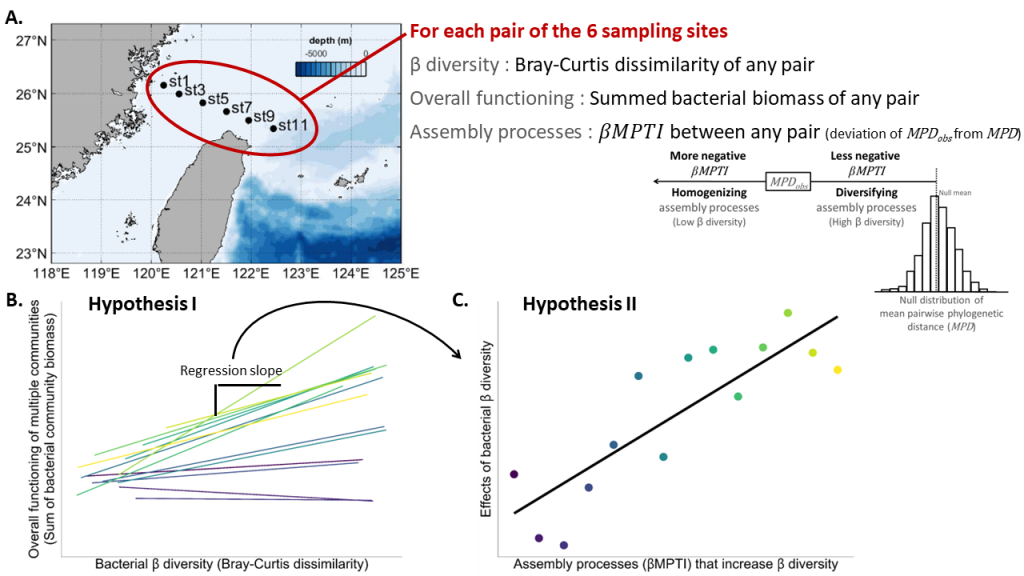Deterministic assembly processes strengthen the effects of β-diversity on community biomass of marine bacterioplankton
Fen-Hsun Chang and Chih-hao Hsieh
Postdoctoral researcher, Feng-Hsun Chang and Prof. Chih-hao Hsieh from the Institute of Oceanography, NTU, proposed a novel approach to examine b-diversity effects on ecosystem functioning of metacommunities. This approach, demonstrated using microbial communities collected from the East China Sea across years, is published in mSystem (Feb. 2023).
It is well known, for long, that diversity of species (α-diversity) in a community often positively influences the ecosystem functioning (e.g., the community biomass) of the community. But natural ecological communities never exist alone. What if we have multiple communities? The research team scales up the concept from a single community to multiple communities. The results indicate that the “diversity across communities (β-diversity)”, i.e., the compositional difference between any two sampling sites (Fig. 1A), positively influences the community biomass of these two communities (supporting the Hypothesis illustrated in Fig. 1B). In addition, and expectedly, such positive influence is further enhanced when these multiple communities are assembled by some kind of non-random processes, like resource partitioning, which is approximated by species’ phylogeny (supporting the Hypothesis illustrated in Fig. 1C), although the specific underlying processes are still worth further exploration. The findings suggest that ecosystem functioning is not only affected by species diversity in a single community, but also the community composition and compositional differences among communities when multiple communities are considered. More importantly, the influences of biodiversity depend on how the communities are assembled. This work expands the current biodiversity-ecosystem functioning framework from single to multiple sampling sites and offers a better mechanistic understanding of the biodiversity-ecosystem functioning relationship.
Reference:
Chang, F. H., J. W. Yang, A. C. Liu, H. P. Lu, G. C. Gong, F. K. Shiah and C. H. Hsieh (2023) Deterministic assembly processes strengthen the effects of β-diversity on community biomass of marine bacterioplankton. mSystem. 8: 1-13. https://doi.org/10.1128/msystems.00970-22
Figure 1.
Schematic plots visualizing the sampling sites, analytical flow, and hypotheses. Panel (A) shows the six sampling sites in the southern East China Sea, methods to quantify the diversity of multiple communities (β-diversity), to calculate the functioning of these communities (sum of community biomass), and to approximate how multiple communities are assembled according to species’ phylogeny. Panel (B) illustrates the first hypothesis: β-diversity increases the sum of community biomass. Panel (C) illustrates the second hypothesis: The effect of β-diversity is stronger when β-diversity is increased more by non-random assembly processes. Each colored line represents the relationship between community biomass and β-diversity for each cruise, and the regression slope is an indicator of β-diversity effect. The regression slopes are shown as colored dots in panel C.











